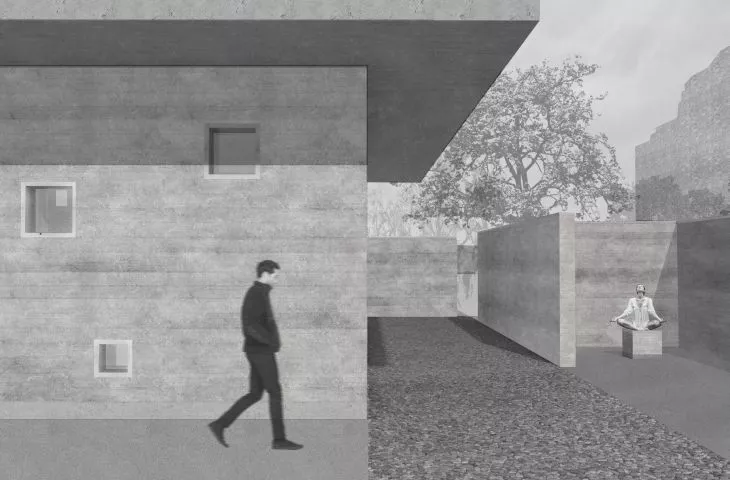A {tag:studenci} from Wroclaw University of Technology designed the Center for Interfaith Dialogue in Beijing. Her design of eight pavilions that are architecturally diverse but form a cohesive space was awarded second prize in an international competition organized by theUNI platform.
The "Faith - Architecture for New Belief Systems" competition organized by the UNI platform was aimed at young architects from around the world. As a task, they were to design a space in Beijing where everyone regardless of religion or lack thereof would find a place for themselves. The proposed facility should be user-friendly, guaranteeing intimacy and spaces for tranquility, as well as visually changing with the seasons.
The awarded project consists of eight pavilions placed along a pathway
© Alicja Kowalewska
second prize for a PWr student
The submitted works were evaluated by a jury consisting of: Vítor Leal Barros (Vítor Leal Barros Architecture), Rafiq Azam (SHATOTTO architecture for green living), Jingsong Xie (West-line Studio), Haobo Wei (West-line Studio). Among the numerous projects was a work by Alicja Kowalewska, which is also an engineering diploma done under the direction of Dr. Jerzy Gomolka. The student's proposal received second prize and was recognized for its poetic concept and well-designed pavilions that act on the senses.
The development area is located in the immediate vicinity of the relics of the Ming Dynasty wall and fits in with its location in the city's network of green areas. In order not to disturb the character of a place full of nature and remaining one of the few places in Beijing with such a low building density rate, I decided to adopt a pavilion convention, creating a strong relationship with the existing nature and historical background," explains the author.
The goal of Alicja Kovalevskaya's project is to create a space of dialogue and community for people with different beliefs or lack thereof. The concept is to build places for contemplation and reverie that meet the spiritual needs of people with different traditions and habits. The author abandoned the usual schemes, drawing from the full spectrum of historical solutions and transferred them to the language of modernity.
The dark interior of the Nature Pavilion
© Alicja Kowalewska
a place for everyone
The designed geometricpavilions are eight structures located along a morphically winding path corresponding to the park's natural surroundings. The winding alley is a symbol of the path of life, and the successive pavilions are peculiar milestones that are an allegory of the passing of time.
The pavilions do not refer by their architecture to any particular religion, but by consciously designing moods and emotions, they give strong expression to the sacred. The proposed concept does not discriminate or indicate the use, allowing the user to adapt it to his spiritual needs. The design is also universal through distinctive elements, drawn as a common part from different religious systems. For this reason, we can experience spaces of meditation and prayer, concentration and mourning here. There are also communal and charitable spaces for building a feeling of belonging," the architect says of the pavilions.
pavilions of the four elements
In designing the pavilions of the Center for Interfaith Dialogue in Beijing, the student also drew on the idea of the four elements - for centuries considered mystical, forming the structure of the world and resonating with the human soul. However, she reversed the order of the elements, according to Plato's theory of Coincidentia oppositorum describing the perfection of the world. Thus, she juxtaposed water with fire and air with earth.
Some of the buildings were inspired by the idea of the four elements
© Alicja Kowalewska
The Air Pavilion would be formed by pillars supporting the roof, between which a semi-transparent fabric would be stretched, gently rippling with the wind while letting it in. Visitors to the center could meditate there, swaying in a spherical swing suspended from the ceiling. Chinese roses would grow around the Earth Pavilion, stimulating with their fragrance, color and multitude of textures. To provide more privacy and shield the pavilion from the strong sun, its interior would be separated by vertical boards. The Fire Pavilion is a small structure in the middle of a field of ash and scorched earth. Under a canopy supported by four legs (rammed earth poles measuring 50 by 50 cm), the author placed a hearth where users could light a fire, sit and tell stories. The Water Pavilion, meanwhile, is located in the middle of a small body of water, accessed by a wooden footbridge.
One of the larger structures is the Mother Pavilion
© Alicja Kowalewska
solace
After passing through the four elements, the first, larger object - the Mother Pavilion- appears by the path. Its soft floor is designed for barefoot walking. The walls are decorated with semi-transparent, bright fabrics that diffuse spot light. Inside, visitors can take advantage of weighted blankets that, adjusted to the user's body weight, provide a sense of solace and security (compared by some to the womb experience). The space is filled with the soft scent of sprayed essential oils with leather notes.
The interior evokes a feeling of maternal care, a primal sense of being taken care of and hugged. The user can use the space in any way he or she wishes, such as for group meditation, solitary meditation, as well as for working through traumas and experiencing deeper transcendental experiences, says the author.
nature and community
The next facility on the tour is the Nature Pavilion. Inside it is semi-dark and one can smell the damp odor of the earth. The floor is made up of mounded earth, in the midst of which one can see a trampled path running around. Adjacent to it are perpendicular places for meditation. In the center is a pond, into which water flows via a bright column.
Nature Pavilion and Community Pavilion
© Alicja Kowalewska
The path then leads to the Community Pavilion. At its heart is a fully-equipped community kitchen that can host all kinds of workshops and cooking classes. It is also a place where meals can be prepared and then served
meals to people affected by poverty. On the outside, there is a small podium and rows of seating that can be used for recreational or ceremonial functions. A social cupboard and refrigerator are located in the wall of the building, working for people experiencing poverty or in crisis of homelessness.
Man strives for acceptance, the need for community and belonging. His spirituality often develops, shapes and strengthens in a group. The Community Pavilion responds to these tendencies and the need to do selfless good," explains the project's author.
experiencing mourning
The final stop on the Path of Life is the Mourning Pavilion. With the help of architectural means, this pavilion allows people to experience the difficult moments after a loss with dignity. In it, the designer planned to gradually reduce stimuli from the outside world and introduce three levels of silence.
The Pavilion of Mourning allows you to calm down
© Alicja Kowalewska
Through the use of narrow, vertical openings, a limited but still quite large amount of ambient light and noise would enter the first corridor. So we would walk along the openings, full of memories, only to find ourselves a moment later in a much quieter space, illuminated sparsely by a delicate strip of diffused light emerging from between the gap between the walls. From here we would enter a place characterized by absolute silence. From a gap in the middle of the ceiling would come a narrow trickle of brightness. This place would be conducive to reverie, contemplation and experiencing mourning, while at the same time connecting us to the spiritual world and our own emotions. We would experience a growth of hope and a gradual return to life as we leave and go through the stages," says Alicja Kowalewska.
Surrounding the pavilion would be a pond and walls, in whose openings visitors could leave various items as an expression of remembrance for loved ones of the deceased. These could be candles, candles, stones, letters or small objects and mementos associated with the person in question.
The pavilions are designed on a square plan
© Alicja Kowalewska
tranquility in the hustle and bustle of the city
The proposed minimalist and form-saving buildings were created on a square projection of 10×10 or 3.5×3.5 meters. Plumbing elements, lintels and roof pitches are not hidden in them. The pavilions are surrounded by walls of three heights framing the views. Thanks to their arrangement, this also allows for sound attenuation of the multi-lane street adjacent to the development site. The author also chose to use materials with a low carbon footprint - local, sustainable and raw in form. These include rammed earth technology and cellulose fiber created by recycling waste paper.





















































